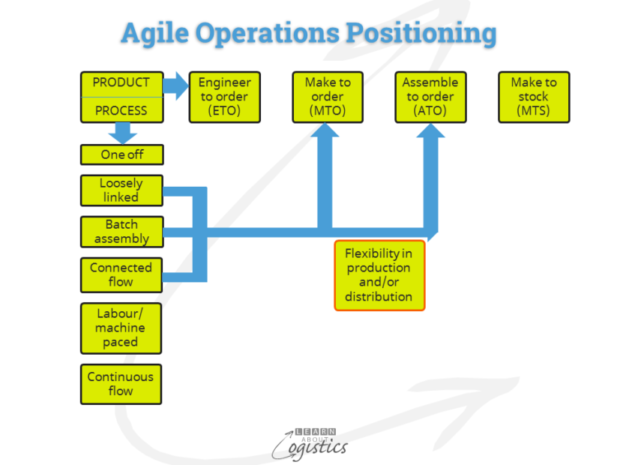Agile sounds a good place to be.
Being Agile in your core supply chains is gaining prominence in media articles and conference streams. This is in comparison with past years and the push for a ‘Lean’ approach. Agile is “having the power of quick motion; nimble”, but can (or should) your business have this objective? Before rushing into an Agile future, consider the changes required.
The Product – Process chart identifies the placement of Agile:

What is the Product emphasis?:
- Engineer to Order (ETO): ‘one-off’ designs, based on customer specification
- Make to Order (MTO): low volume, high variety. Adaptation of pre-designed products – provide a design service for options to the base products
- Assemble to order (ATO): low volume, high variety (could be high volume, low variety): Assemble discrete or ‘mix and stir’ non-discrete products to order; based on specific orders from either customers or sales for defined catalogue or recipe products. Make or buy materials, components, sub-assemblies, packaging and options to:
- Immediately assemble into finished goods and deliver, using ‘just in time’/lean flow manufacturing processes
- Assemble stocked items or ‘mix and stir’ ingredients and deliver. This is an example of ‘postponement’ or delayed configuration
- Make to stock (MTS): high volume production and sale of standard products. Sell from finished goods inventory:
- Produce discrete finished goods (stock keeping units (SKUs)) from materials, components, sub-assemblies and packaging, then hold in inventory
- Produce non-discrete (process, that often have a use-by date) finished goods from ingredient materials that are processed into end products, co-products or by-products, then hold in inventory
- Make and distribute ‘short shelf life’ (perishable) products, such as wheat and dairy products and fresh seafood
- Import finished products and hold in inventory
Changes in demands by major retailers for smaller volumes of more products (called ‘line extensions’) may entail a brand company having a ‘long tail’ of low volume SKUs. Long tail items have:
- Lumpier and more unpredictable demand patterns that do not provide a normal demand distribution used in inventory calculations
- Longer replenishment times due to uncertainty of future demand and higher forecast error
- A higher number of demand locations (retailer and on-line shopping site shelves)
- High service levels expected for low selling items
These mean that uncertainty (risks) and complexity are likely to increase. As order size decreases, but (hopefully) total delivery volumes increase, lead times through the supply chains need to be shortened. This requires supply from ‘agile’ factories and distribution centres. However, if the ordering, manufacturing and distribution processes do not change, flexibility in operations will incur additional costs, so changes are required to improve effectiveness.
Agile is the term used for flexibility in operations. As shown in the diagram, an Agile approach works best in the Make to Order and Assemble to Order environment that utilise the Process approaches of: loosely linked job shop; disconnected line flow (or batch) and connected line flow
To offset price competition from MTS companies, in addition to flexibility, emphasise product attributes such as design, packaging and ingredients. If your business produces and sells standardised, commodity products, then aim to be a low cost producer (emphasising ‘Lean’ characteristics) in a Make to Stock environment.
Changes to make when going Agile
The diagram indicates that an Agile approach is more likely to fit where companies are less capital intensive (but could incorporate new technologies), therefore more flexible and more reliant on their human capital. A flexible workforce requires training and skill levels to safely undertake the variable job roles. The more skills required of a person, the higher wage paid.
Planning factors to be considered when moving to an Agile (MTO and ATO) model are:
- Flexibility requires excess capacity closer to customers – accountants should be trained to understand the benefits of flexibility that requires lower equipment utilisation
- Flexibility increases closer to customers i.e. packaging machines purchased for their flexibility (quick changeover time) rather than output speed
- Upstream operations from the Order Penetration Point (OPP) will be either MTS (for lowest cost) or MTO (for flexibility). In a process product situation, rather than a few large holding tanks, consider using multiple (small) holding tanks for low volume, quality controlled batches that can be processed in short run batches on flexible packing lines
- Product variations must be created, completed and distributed with limited storage or out of season (fashion) risks
- Operations are better able to align with market demands when the Order Penetration Point (OPP) is responding to market and environment events
ATO or MTO operations require a ‘delayed configuration’ or ‘postponement’ approach to inventory. Sub-assemblies are made from standard parts, components or ingredients and held in inventory. The final configuration is delayed until a firm order is received:
- the total value of inventory is reduced
- inventory held at a generic level can be more easily balanced with actual customer orders and
- forecasting at a generic sub-assembly level is more accurate than at the SKU level
ATO or MTO operations can affect an organisation’s ‘cost to serve’:
- Improved engagement with customers e.g. co-design of products and improved product and process quality
- The extent of supplier involvement and supplier rationalisation
- Incorporating the knowledge acquired from customers and suppliers to the business
- Implementing new technologies should enable Agile businesses to be more effective in meeting customer requirements
- Effective utilisation of upstream production and downstream distribution or expand outsourcing
- Quick decisions require a reduction in organisation layers and span of control for managers and supervisors
- IT applications configured for ATO and MTO operations
Adopting an Agile structure within your core supply chains will enable a better response to changing expectations and patterns of customer demand. However, it requires an ‘effective’ rather than ‘efficient’ focus, which will take time for acceptance by senior management and then for the implementation. As with many aspects of supply chains, Agile is easier said than done!

